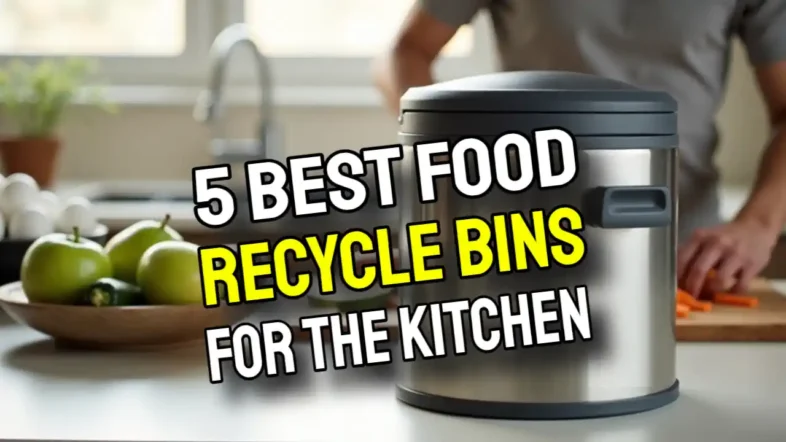Choose the best food recycle bins for your Kitchen, between countertop caddies for holding food scraps temporarily, freestanding dual-compartment bins for sorting all kitchen waste, and even electric composters for accelerated home processing. The best choice depends on how much waste you produce and how often your council collects it, or you transfer it to your compost pile.
Key Takeaways
- The Epica Stainless Steel Compost Bin tops our list for its durability, odour control, and perfect size for most households.
- Stainless steel bins generally outperform plastic options in terms of longevity and odour containment.
- Effective kitchen compost bins should include charcoal filters and be sized to hold 3-4 days of food waste.
- Even simple solutions like a dedicated mixing bowl can serve as an entry-level food recycling system.
- Proper food waste recycling can divert up to 30% of household waste from landfills, significantly reducing methane emissions.
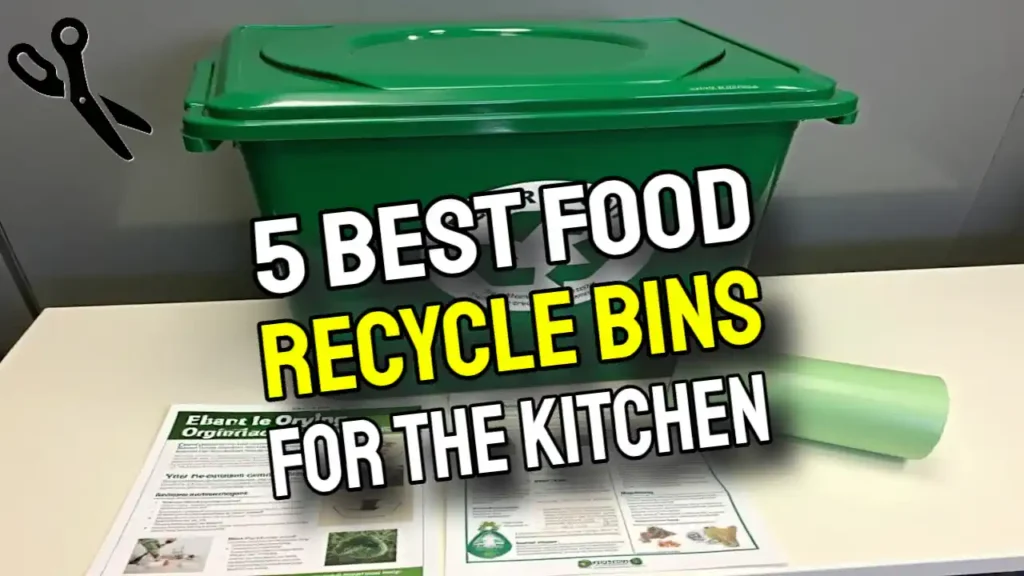
Transforming kitchen scraps into nutrient-rich compost is one of the simplest yet most impactful sustainability practices you can adopt. The right kitchen food recycling bin makes all the difference between a pleasant experience and one that's abandoned after the first whiff of decomposing vegetables.
After testing numerous models and consulting with EcoKitchen Essentials' sustainable living experts, I've identified the bins that make food waste recycling practically effortless.
The best kitchen food recycle bins blend seamlessly into your cooking routine while effectively containing odours and looking good enough to display proudly.
Whether you're a seasoned composter or just starting your sustainability journey, finding the perfect bin is essential for long-term success.
Let me guide you through the options that will transform your kitchen waste management without transforming your kitchen into something less pleasant.
Kitchen Scraps to Garden Gold: What You'll Learn
In this comprehensive guide, you'll discover which features matter most in a kitchen compost bin, from materials and capacity to odour control mechanisms.
I'll share insights on how different household sizes affect your bin choice and reveal the unexpected benefits of various designs. Most importantly, you'll learn how to integrate food recycling into your daily routine without adding stress or unpleasant odours to your life.
The perfect bin varies depending on your lifestyle, kitchen size, and composting goals. Some households need large-capacity bins for frequent cooking, while others prioritise sleek designs that complement modern kitchens. If you're interested in how household design can impact functionality, you might also find insights in this review of photo collage frames. By the end of this article, you'll know exactly which bin matches your unique needs.
Remember that the ultimate goal isn't just having a pretty container on your counter—it's diverting valuable organic matter from landfills and potentially creating nutrient-rich amendments for plants or gardens.
Transform Your Kitchen Waste Today: Top Food Recycling Bins
The kitchen compost bin market has evolved dramatically in recent years, moving beyond the basic plastic containers of the past. Today's options feature sophisticated odour-control technologies, ergonomic designs, and materials that resist bacterial buildup.
When selecting the right bin, consider factors like capacity (most households need between 1-1.5 gallons), counter space availability, and your emptying frequency preferences. The most effective bins allow air circulation while containing odours through activated charcoal filters that need replacing every 3-6 months.
5 Best Kitchen Compost Bins for Every Home
After weeks of testing and research, I've identified five standout kitchen compost bins that excel in different categories. Each bin offers unique advantages depending on your household size, aesthetic preferences, and composting habits.
From stainless steel workhorses to stylish ceramic options, these bins represent the best balance of functionality, durability, and value.
When evaluating these bins, I considered factors like odour containment, ease of cleaning, durability, and how seamlessly they integrate into different kitchen environments.
Price was also considered, but I prioritised long-term value over initial cost since a quality bin should last for many years. For those interested in sustainable practices, incorporating recycled materials into your kitchen can enhance both functionality and eco-friendliness.
1. Epica Stainless Steel Compost Bin – Best Overall
The Epica Stainless Steel Compost Bin emerges as the clear winner for most households. With a perfect 1.3-gallon capacity, this bin strikes the ideal balance between counter footprint and functionality.
Its stainless steel construction prevents absorption of odours and resists staining, while the replaceable charcoal filter in the lid effectively blocks smells from escaping. During testing, I filled it with notoriously pungent items like onion peels and coffee grounds, and was impressed by how well it contained odours even after several days.
What truly sets the Epica apart is its thoughtful design—the interior is completely seamless, eliminating any crevices where food particles might hide and cause odours.
The lid creates a secure seal but remains easy to remove with one hand while cooking. At around $30, it represents excellent value considering its durability and performance.
Households of 2-4 people will find it holds approximately 3-4 days of typical food scraps before needing emptying.
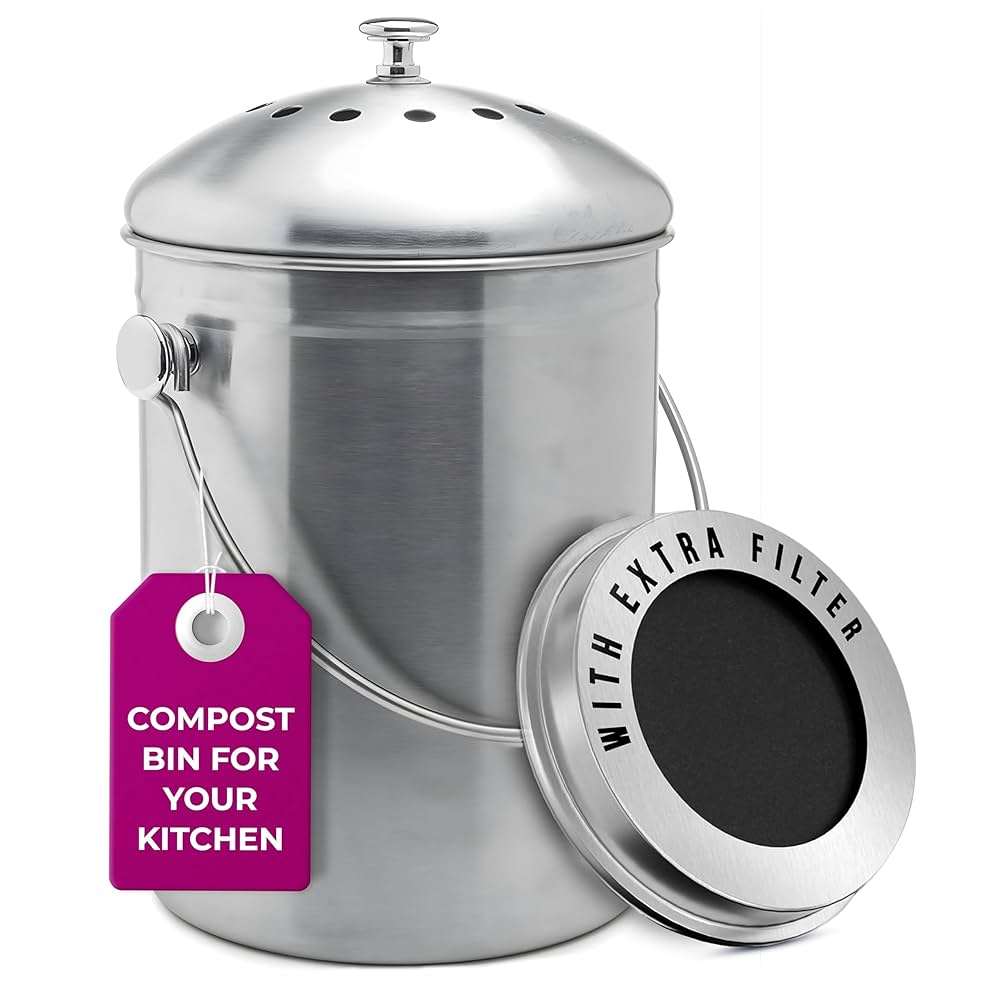
“EPICA Countertop Compost Bin Kitchen …” from www.amazon.com and used with no modifications.
Check the Current PriceEpica Stainless Steel Compost Bin Specifications
Capacity: 1.3 gallons
Material: Stainless steel (won't rust or absorb odors)
Filter: Replaceable charcoal filter (lasts 4-6 months)
Dimensions: 7.16 x 7.16 x 11 inches
Weight: 1.8 pounds
Dishwasher safe: Yes2. OXO Easy-Clean Compost Bin – Most User-Friendly
OXO's reputation for user-friendly kitchen tools extends perfectly to their Easy-Clean Compost Bin. This model features a smooth interior with rounded corners that prevent food from getting trapped, and the lid opens with a simple flip that can be operated with one hand. Unlike many competitors, the OXO's lid is completely removable, allowing for easy emptying and thorough cleaning. The bin's 0.75-gallon capacity makes it ideal for smaller households or those who empty their compost more frequently. For more information on choosing the best compost bins, check out Wirecutter's review on compost bins.
The clever design includes a rotating handle that tucks away when not in use and a lid that stays open when desired—perfect for extended cooking sessions. While constructed of plastic rather than stainless steel, the high-quality, BPA-free material doesn't absorb odors and withstands repeated cleaning. The slightly smaller capacity means more frequent emptying, but the trade-off is a more compact footprint that works well in space-constrained kitchens. For more information on selecting the best compost bin for your needs, consider checking out this review on the best compost bins.
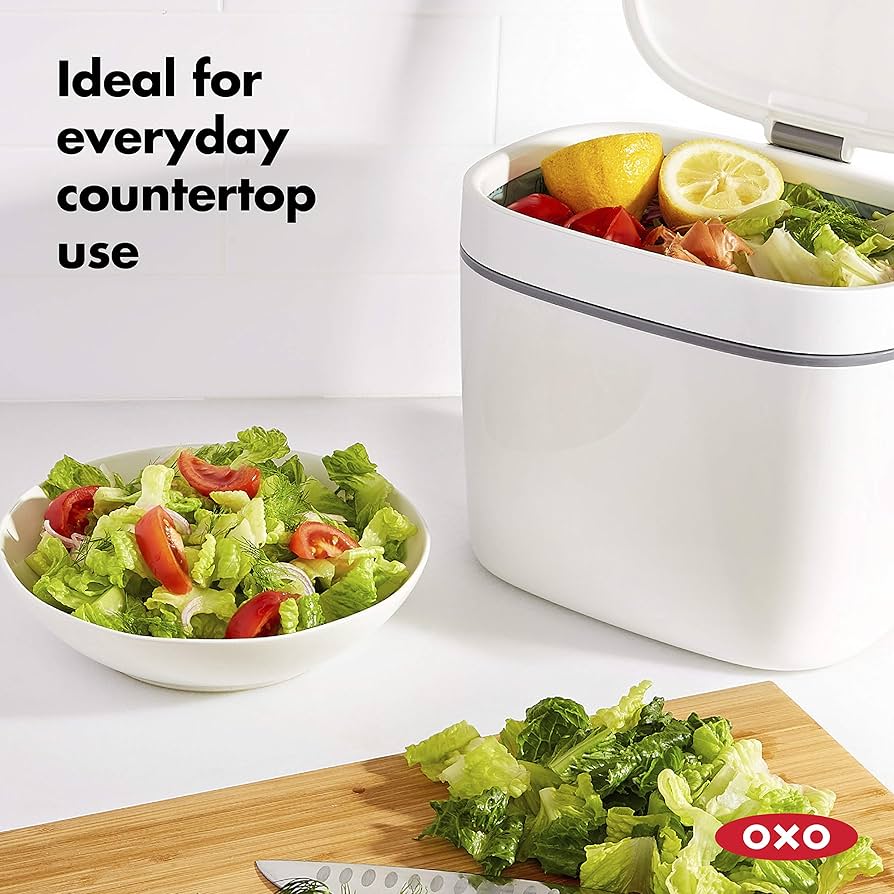
“OXO Good Grips EASY-CLEAN COMPOST BIN …” from www.amazon.com and used with no modifications.
Check the Current Price3. SimpleHuman Compost Caddy – Perfect for Tight Spaces
The SimpleHuman Compost Caddy stands out for its ingenious space-saving design that works in even the most compact kitchens. This slim bin can attach to the inside of a cabinet door or sit neatly on your counter, making it perfect for apartment dwellers or anyone with limited space. Despite its small footprint, it offers a surprising 1.0-gallon capacity that can handle a couple days' worth of food scraps for most households.
SimpleHuman's attention to detail shines through with the bin's magnetic dock that allows for one-handed removal when emptying, and the smooth interior surface that prevents food particles from sticking. The removable inner bucket features a smart rim design that hides any bag liner you might use, maintaining the caddy's sleek aesthetic. While slightly more expensive than other options, the premium materials and thoughtful engineering justify the investment for those who value both form and function in their kitchen tools.
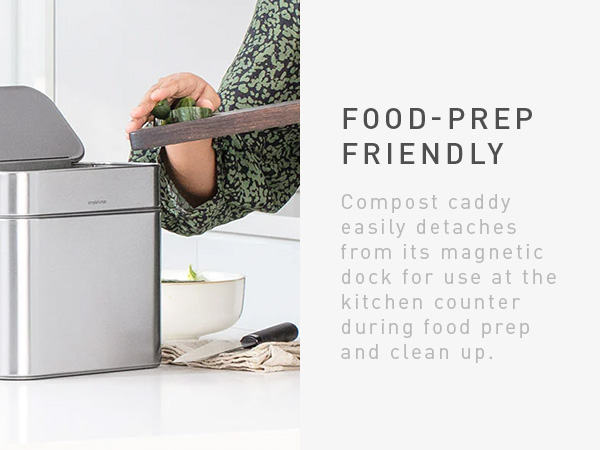
“Amazon.com: simplehuman Compost Caddy …” from www.amazon.com and used with no modifications.
4. Exaco Eco 2000 Kitchen Compost Pail – Largest Capacity
For larger households or enthusiastic home cooks, the Exaco Eco 2000 offers an impressive 2.4-gallon capacity that can accommodate several days' worth of food scraps. This bin is particularly well-suited for families of 4+ or anyone who prepares most meals at home. The larger size means fewer trips to the outdoor compost pile or community collection point, saving time and effort.
Despite its generous capacity, the Exaco features a relatively compact design with a square footprint that maximises storage efficiency. The heavy-duty plastic construction includes an activated carbon filter in the lid and reinforced carrying handles for easy transport. This bin's substantial size does mean it requires dedicated counter space or a specific storage location, but for serious composters, the convenience of fewer emptying cycles makes it well worth the space commitment.
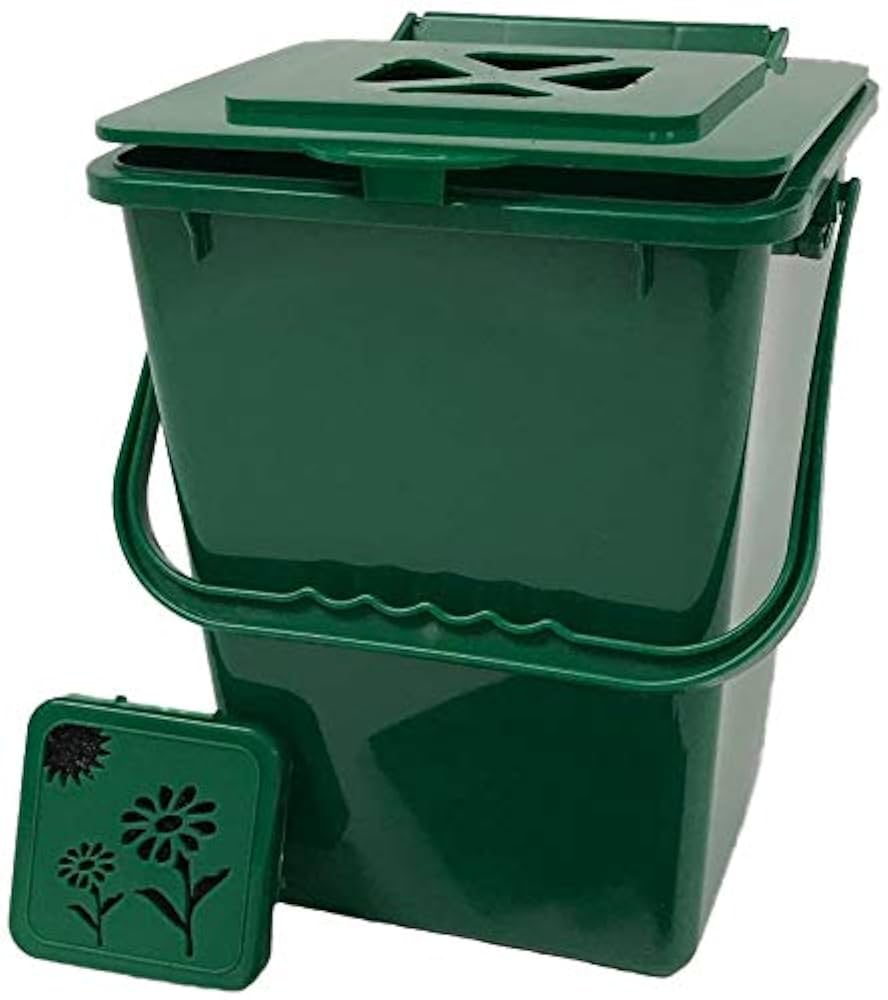
“Exaco ECO 2000-NP Kitchen Compost Pail …” from www.amazon.ae and used with no modifications.
Check the Current Price5. Typhoon Compost Caddy – Most Compact Design
At just 84 ounces (0.65 gallons), the Typhoon Compost Caddy is the smallest option on our list, but what it lacks in size it makes up for in style and efficiency. This vintage-inspired bin features a powder-coated steel exterior available in several attractive colors, making it a design feature rather than something to hide away. The compact size makes it perfect for singles, couples, or anyone with minimal counter space.
The Typhoon includes a replaceable charcoal filter and a sturdy carrying handle for easy transport. Its smaller capacity necessitates more frequent emptying—typically every 1-2 days for most users—but the trade-off is a bin that takes up minimal space and adds aesthetic appeal to your kitchen. For urban dwellers or those just beginning their composting journey, this little powerhouse provides the perfect entry point to sustainable food waste management.
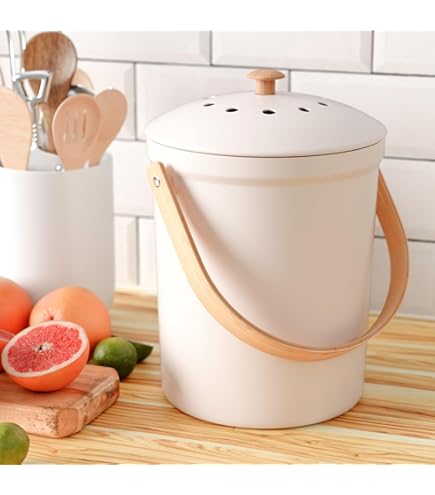
“Typhoon Living Collection Large Compost …” from www.amazon.com and used with no modifications.
Check the Current PriceWhy Every Kitchen Needs a Dedicated Food Recycling Bin
Implementing a food recycling system in your kitchen creates ripple effects far beyond the immediate space savings in your trash can. Food waste accounts for approximately 30% of what we throw away, and when this organic material ends up in landfills, it generates methane—a greenhouse gas 25 times more potent than carbon dioxide. A dedicated compost bin interrupts this cycle, diverting valuable nutrients away from landfills and potentially back into local soil systems.
The Hidden Environmental Cost of Food Waste
When food scraps decompose in landfills, they do so anaerobically (without oxygen), generating significant methane emissions. This process contributes substantially to climate change while wasting the potential nutrients contained in these scraps. By contrast, properly composted food waste breaks down aerobically, producing minimal methane and creating nutrient-rich soil amendments instead of pollution. Every pound of food you divert from the landfill prevents approximately 2.6 pounds of CO2-equivalent greenhouse gases from entering the atmosphere.
Compost Benefits for Your Garden and Wallet
Beyond environmental benefits, composting creates “black gold”—nutrient-dense material that enriches soil and reduces the need for chemical fertilisers. Home gardeners who use compost typically see stronger plants, higher yields, and improved soil structure. Even if you don't garden, many communities now offer compost collection services or drop-off points, and some even provide finished compost back to residents for free or at minimal cost. For those interested in treehouse projects, understanding oak tree analysis for treehouse support can be beneficial as it relates to the health of your garden ecosystem.
The financial benefits extend beyond free soil amendments. Many municipalities charge for trash collection by volume, meaning less trash equals lower bills. Some communities even offer rebates or discounts for households that participate in composting programs, recognising the municipal cost savings when organic waste is diverted from landfills.
Odour and Pest Control Advantages
Contrary to common misconceptions, a properly managed kitchen compost bin actually reduces household odours rather than creating them. When food scraps mix with regular trash, they create that unmistakable garbage smell that permeates the kitchen. By separating compostable materials and containing them in a purpose-built bin with odour control features, you'll notice your regular trash stays drier and less smelly.
The quick removal of food waste from your main garbage also reduces the likelihood of attracting pests. Many insects and rodents are drawn to the smell of decomposing food in trash cans, but a sealed compost bin with a carbon filter effectively contains these attractants. This separation creates a cleaner, more hygienic kitchen environment overall.
Stainless Steel vs. Plastic: Material Matters
The material of your kitchen compost bin significantly impacts its performance, longevity, and environmental footprint. After testing both stainless steel and plastic models extensively, I've found that material choice affects everything from odour retention to cleaning ease and overall durability. While both materials can produce functional bins, understanding their differences helps you make a more informed choice that aligns with your specific needs.
Your bin will be handling decomposing organic matter daily, making material properties particularly important. Let's examine how these two common materials compare across several crucial factors.
Durability and Longevity Comparison
Stainless steel bins consistently outperform plastic in longevity tests, often lasting 5-10 years or more with proper care. The non-porous surface of stainless steel resists scratches and prevents bacteria from establishing colonies in microscopic grooves. During my testing, I noticed that stainless steel bins maintained their appearance and functionality even after months of daily use, while some plastic bins began showing wear much sooner. If you're interested in exploring alternatives, check out this review of photo collage frames for another durable home decor option.
High-quality plastic bins can certainly provide years of service, but they're more susceptible to scratching during cleaning and may absorb stains from colourful food waste like beet trimmings or turmeric. These scratches not only affect appearance but can harbour bacteria that contribute to odour problems. If you opt for plastic, look for thick-walled, BPA-free models with smooth interior surfaces that minimise these issues.
Odour Containment Capabilities
Perhaps the most significant advantage of stainless steel is its non-absorbent nature. Unlike plastic, which can absorb odours over time, stainless steel remains neutral regardless of what you've been composting. In side-by-side tests with identical food scraps, stainless steel bins consistently produced less noticeable odour after several days, particularly when handling strong-smelling items like onion peels and fish scraps.
That said, modern plastic bins with well-designed carbon filters can perform admirably. The key difference emerges over time – after 6-12 months of use, many plastic bins begin to retain subtle odours even when empty and cleaned, while stainless steel bins return to a neutral state. This makes stainless steel a better long-term investment for odour-sensitive households.
Environmental Impact of Your Bin Choice
From an environmental perspective, stainless steel offers advantages in both production impact and end-of-life considerations. While steel production does require significant energy, these bins typically last many years longer than plastic alternatives, amortising that initial impact. Stainless steel is also 100% recyclable, with established recycling streams available in most communities.
For plastic bins, look for those made from recycled content to reduce their environmental footprint. Unfortunately, even bins marketed as recyclable may face challenges in actual recycling facilities due to food residue or composite materials. The longer lifespan of stainless steel means fewer resources consumed and less waste generated over time, making it generally the more sustainable choice despite its higher initial carbon footprint.
Smart Features That Make Food Recycling Easier
The difference between a compost bin that becomes a permanent part of your routine and one that gets abandoned after a few weeks often comes down to thoughtful design features. Modern bins incorporate innovative technologies and designs that address common pain points like odours, fruit flies, and messy emptying. These quality-of-life improvements make the composting process significantly more pleasant.
Charcoal Filters: How They Stop Smells
Activated charcoal filters work through adsorption – the process where odour molecules physically bind to the charcoal's highly porous surface. This natural material creates a remarkable odour barrier without chemicals or fragrances. Most quality bins use replaceable filter discs that fit into the lid, creating a permeable barrier that allows air exchange while trapping odorous compounds.
For optimal performance, replace filters every 3-6 months, depending on usage. Some users find they can rejuvenate filters by placing them in direct sunlight for a few hours, which helps release captured compounds and extend filter life. When purchasing a bin, check the availability and cost of replacement filters – some universal filters can fit multiple models, potentially saving money over time. For more information on choosing the right bin, check out this guide to the best compost bins.
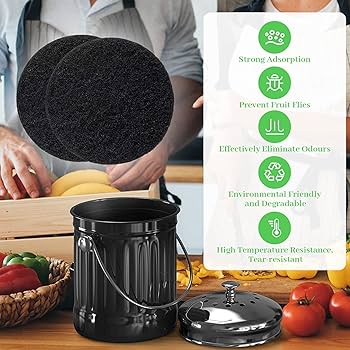
“Compost Bin Charcoal Filters …” from www.amazon.com and used with no modifications.
Check the Current PriceEasy-Access Lids and Hinges
Lid design dramatically impacts the daily usability of your compost bin. The best lids open with one hand (crucial when your other hand is holding food scraps) and create a reliable seal when closed. During testing, I found that hinged lids offer the best combination of convenience and odour control, preventing the common problem of misplaced or dropped lids during cooking.
Some innovative models, like the SimpleHuman, feature magnetic closures or soft-close mechanisms that prevent slamming. Others incorporate silicone gaskets that create an extra barrier against odours and fruit flies. The seemingly small convenience of a well-designed lid makes a tremendous difference when you're using the bin multiple times daily.
Cleaning and Maintenance Innovations
Even the best compost bin requires occasional cleaning, and smart design features can make this chore significantly easier. Bins with rounded interior corners prevent food from getting trapped in crevices, while removable inner buckets allow for thorough cleaning without moving the entire bin. Many stainless steel models are dishwasher-safe, offering the most convenient cleaning option.
Some bins now include antimicrobial coatings that inhibit bacterial growth, though I remain somewhat sceptical about their long-term effectiveness compared to regular cleaning. More practical innovations include measurement markings on the inside (helpful for gardeners tracking nitrogen/carbon ratios) and handles positioned to prevent spills during emptying. The easier a bin is to maintain, the more likely you'll continue using it consistently.
Size Considerations for Different Households
Bin capacity should align with your household size and composting habits. For single-person households or those with minimal cooking, a compact 0.5-1 gallon bin typically suffices. Families of 3-4 benefit from medium-sized bins in the 1-1.5 gallon range, while larger families or avid home cooks may need capacities of 2+ gallons.
Consider your emptying routine when selecting size – smaller bins require more frequent emptying but take up less counter space and tend to generate fewer odors between emptyings. If you only empty your bin weekly (when taking it to a community collection point, for example), you'll need a larger capacity than someone who empties it daily into a backyard composter. Finding the right balance between capacity and footprint ensures your system remains practical for your specific situation.
Alternative Food Waste Solutions
While dedicated compost bins offer the most complete solution, several alternative approaches can work well for different situations. These options range from ultra-simple methods requiring no special equipment to innovative systems that accelerate the breakdown process. Each offers unique advantages depending on your space constraints, budget, and composting goals.
Freezer Storage Options
Freezing food scraps completely eliminates odour concerns and stops the decomposition process until you're ready to empty your container. This method works well for apartment dwellers or those without immediate access to compost collection. Simply designate a container—anything from a repurposed ice cream tub to a dedicated compost pail—and store it in your freezer.
The freezer method offers exceptional flexibility, as you can accumulate scraps for weeks without odor issues. Some composters find that freezing actually accelerates the breakdown process once scraps are added to the compost pile, as the freezing and thawing process breaks down cell walls. The main drawback is limited freezer space, which may create competition with food storage needs.
Biodegradable Bag Systems
For those seeking convenience, biodegradable compost bags offer a neat solution that minimizes bin cleaning. These bags, typically made from cornstarch or other plant-based materials, contain food scraps and can be composted along with their contents. When used with a supporting bin or caddy, they create a clean, low-maintenance system.
- Cornstarch bags break down completely in industrial composting facilities
- Paper bags offer a more breathable alternative that reduces moisture buildup
- Newspaper linings provide a free, readily available option
- Certified compostable bags (look for BPI certification) ensure proper breakdown
While convenient, these bags add ongoing cost to your composting system. They work best in bins designed specifically to hold them, with edges that keep the bag open and accessible during use. Most biodegradable bags are not suitable for home composting systems, as they require the higher temperatures achieved in industrial facilities to break down completely.
Some municipalities have restrictions on which types of biodegradable bags are accepted in their composting programs, so check local guidelines before committing to this system. Despite these considerations, bag systems offer a practical compromise between convenience and sustainability for many households.
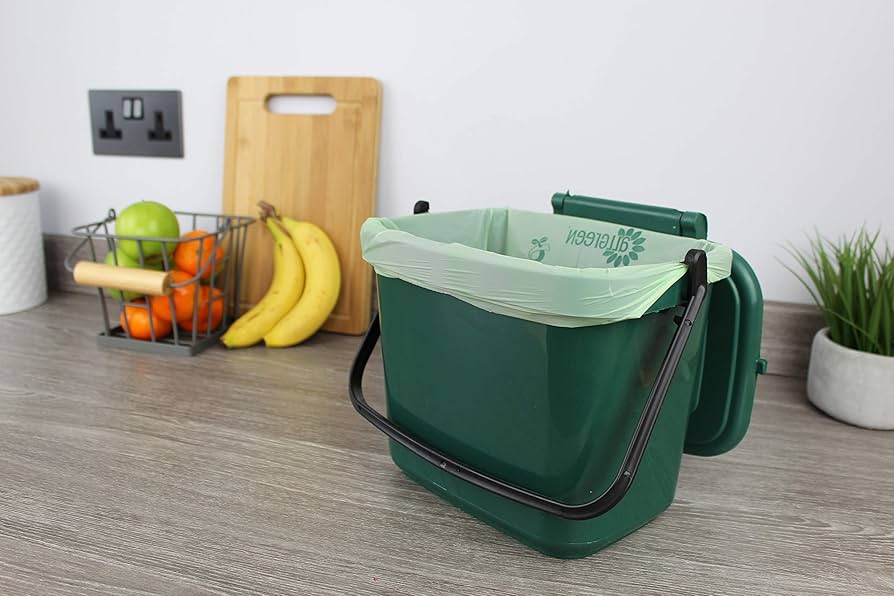
“Food Waste Bin Liners …” from www.amazon.com and used with no modifications.
Check the Current PriceYour Green Kitchen Starts Now
Remember that every banana peel, coffee ground, and vegetable scrap diverted from the landfill represents a small but meaningful victory for sustainability. By transforming waste into a resource, you're participating in a natural cycle that has nourished our planet for millennia. The perfect kitchen compost bin simply makes this ancient practice more accessible in our modern lives. Ready to take your sustainable kitchen journey even further? EcoKitchen Essentials offers comprehensive guides and solutions for the environmentally conscious home cook.
Frequently Asked Questions
Throughout my years helping households establish composting routines, certain questions have arisen consistently. These FAQs address the most common concerns and challenges that newcomers encounter when setting up their kitchen food recycling systems.
How often should I empty my kitchen compost bin?
Most kitchen compost bins should be emptied every 3-5 days to prevent odour buildup and fruit fly issues. Factors affecting this frequency include bin size, local climate, and the types of food scraps you're collecting. Bins with activated charcoal filters can sometimes extend to weekly emptying, while smaller bins or those containing high-odour items like onions may require more frequent attention. During summer months, plan for more frequent emptying as higher temperatures accelerate decomposition and potential odour development.
Do I need special liners for my compost bin?
Liners are optional for most compost bins, but can make cleaning easier and reduce the need for frequent bin washing. If you choose to use liners, ensure they're compostable (look for BPI certification) rather than just biodegradable. Newspaper, paper bags, or commercially available compostable bags all work well, though their suitability depends on your end destination for the compost.
For community composting programs, check local guidelines, as some accept certain liners but reject others. Home composting systems generally do better with paper-based liners or no liners at all, as many “compostable” plastic alternatives require industrial composting conditions to break down fully.
Some composters find that lining their bin with a few sheets of newspaper absorbs excess moisture and makes emptying cleaner without adding significant cost. For more tips on sustainable practices, you might find this guide on incorporating recycled materials into your daily life helpful.
Can I put meat and dairy in my kitchen compost bin?
While technically compostable, meat, dairy, and oily foods are generally not recommended for home composting systems.
These items break down slowly, can create strong odours in your kitchen bin, and potentially attract pests to your outdoor compost pile. However, if you're participating in a municipal composting program, many of these systems can accept these materials due to their industrial-scale processing that achieves higher temperatures.
Always check your local program guidelines, as some community composting services explicitly welcome these items while others prohibit them.

How do I prevent fruit flies in my compost bin?
Fruit flies are attracted to fermenting food, making compost bins a potential breeding ground if not properly managed. The most effective prevention strategy is frequent emptying—at least every 3-4 days during warmer months.
Ensure your bin creates a good seal when closed, and consider models with charcoal filters that block both odours and tiny insects. Some users find that storing fruit scraps in the freezer until emptying day eliminates the fruit fly issue entirely.
If flies do appear, a thorough cleaning with vinegar (focusing on the rim and lid where eggs may be laid) usually resolves the problem within a few days. For additional tips on maintaining your outdoor spaces, you might find this guide to rain-proofing treehouses helpful.
Should I keep my compost bin on the counter or under the sink?
Both locations have advantages, with the best choice depending on your kitchen layout and personal preferences. Counter placement offers maximum convenience during food preparation but consumes valuable workspace. Under-sink storage conserves counter space but may reduce accessibility during cooking, potentially creating a barrier to consistent use.
The ideal location is within arm's reach of your primary cutting and preparation area, whether that's on the counter, mounted to a cabinet door, or in a pull-out drawer.
Consider factors like bin size, kitchen traffic patterns, and aesthetic preferences when deciding. Some households successfully use a hybrid approach: a small container on the counter for active meal preparation that gets emptied into a larger bin stored elsewhere. Whatever location you choose, prioritise ease of access to encourage daily use.
Starting your kitchen composting journey represents a simple yet powerful step toward more sustainable living.
By selecting the right bin for your needs and establishing consistent habits, you'll transform waste into a valuable resource while reducing your environmental footprint. The perfect system isn't about having the most expensive equipment—it's about creating a routine that works seamlessly with your lifestyle and kitchen space.
When it comes to enhancing your wardrobe with eco-friendly options, consider incorporating recycled materials. A great way to start is by adding recycled wool scarves to your collection. These scarves not only offer a sustainable choice but also provide warmth and style, making them a perfect accessory for any outfit.
Check the Current Price